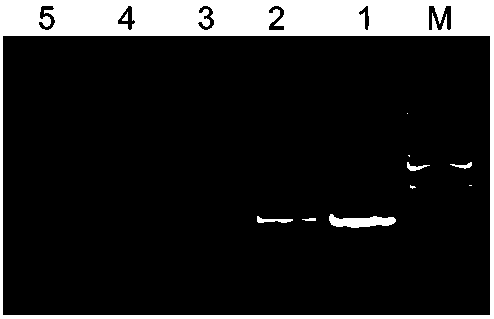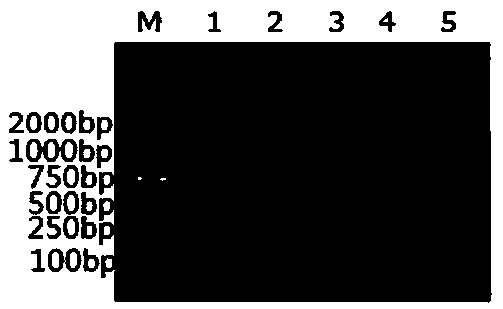A lamp detection method for identifying mink meat from beef and mutton using mitochondrial DNA
A detection method, the technology of beef and mutton, is applied in the field of molecular biology detection, which can solve the problems of difficult popularization and application and long time-consuming, and achieve the effects of broad market prospect, simple operation and easy judgment of results
- Summary
- Abstract
- Description
- Claims
- Application Information
AI Technical Summary
Problems solved by technology
Method used
Image
Examples
Embodiment 1
[0031] Example 1 Design primers
[0032] The COXI sequence of mink was retrieved from GenBank, and software comparison analysis was performed to confirm the accuracy of the sequence; according to the above sequence, primers were designed using PrimerExplore software as follows:
[0033] DAF3: GCTATGGGCCTTAGGGTT (as shown in SEQ ID NO.1),
[0034] DAB3: CATTTAGGGTGTAGCCTGT (as shown in SEQ ID NO.2),
[0035] DAFIP: GTGAAGAACGATGTCTAGTGATGAGTTTTATTTACAGTGGGTGGC (shown in SEQ ID NO.3),
[0036] DABIP: GCACATTTTCACTACGTTCTTTCAAGGAACCAGTGAACGAATCC (shown in SEQ ID NO. 4).
Embodiment 2
[0037] Embodiment 2 specificity experiment
[0038] (1) Extract sample DNA as a template
[0039] The fresh muscle tissues of cattle, sheep, dogs, cats, foxes, and minks were strictly aseptically collected as samples, and then the DNA in the samples was extracted by phenol-chloroform extraction method. Use ultrapure water (negative control), positive plasmid containing mink meat COXⅠ gene (positive control), beef DNA, mutton DNA, dog meat DNA, cat meat DNA, fox meat DNA, and mink meat DNA as templates. A LAMP reaction system was established; the DNA template concentration was 20ng / uL.
[0040] (2) Establishment of LAMP reaction system
[0041] The LAMP reaction system established by exploring the concentration ratio of internal and external primers, dNTP concentration, reaction temperature, reaction time, etc.: 25 μL, its composition is: 0.5uL each of 10umol / L DAF3 and DAB3, 4uL each of 10umol / L DAFIP and DABIP, 2.5 mmol / L of dNTP 4uL, 50mmol / L of MgSO 4 2uL, 2.5uL of 5mo...
Embodiment 3
[0046] Collect 30 fresh beef samples and 30 fresh mutton samples from the slaughterhouse in Shandong Province; collect 10 fresh mink meat samples from Shandong Animal Hospital; use the method of Example 1 to extract the DNA of the samples as a template, set up a LAMP reaction system, and carry out LAMP amplification reaction, detection results are shown in Table 1:
[0047] Table 1
[0048]
beef
mutton
mink meat
beef and lamb
beef and mink
lamb and mink
Number of samples
30
30
10
30
10
10
number of positives
0
0
10
0
10
10
Positive ratio / %
0
0
100
0
100
100
[0049] It can be concluded from Examples 2 and 3 that the primers in Example 1 can specifically amplify mink DNA, and only when the template contains mink DNA, the reaction solution after adding the fluorescent dye SYBR GREEN Ⅰ to the LAMP reaction product turns green ; while the template contains any other no...
PUM
 Login to View More
Login to View More Abstract
Description
Claims
Application Information
 Login to View More
Login to View More - R&D
- Intellectual Property
- Life Sciences
- Materials
- Tech Scout
- Unparalleled Data Quality
- Higher Quality Content
- 60% Fewer Hallucinations
Browse by: Latest US Patents, China's latest patents, Technical Efficacy Thesaurus, Application Domain, Technology Topic, Popular Technical Reports.
© 2025 PatSnap. All rights reserved.Legal|Privacy policy|Modern Slavery Act Transparency Statement|Sitemap|About US| Contact US: help@patsnap.com



